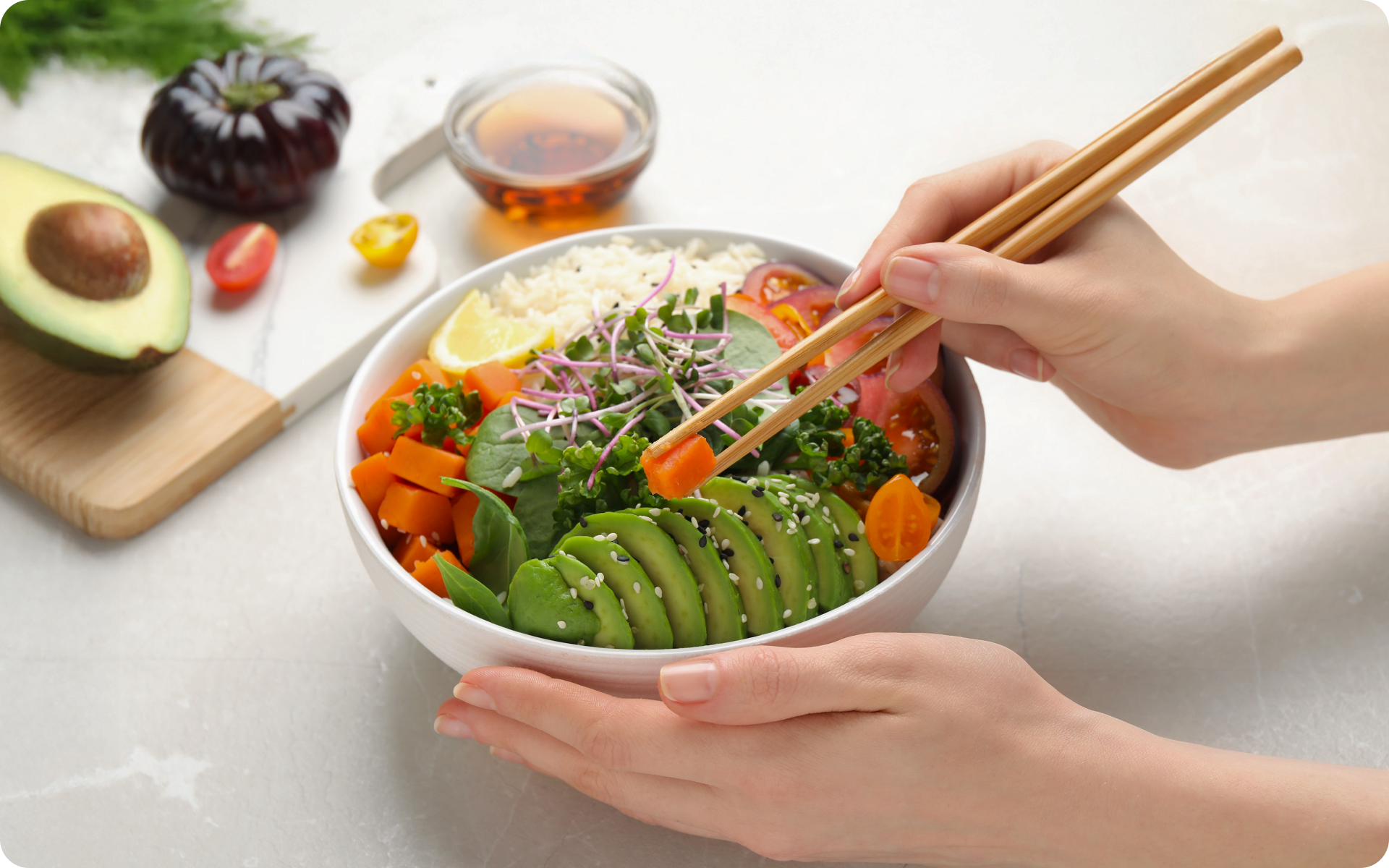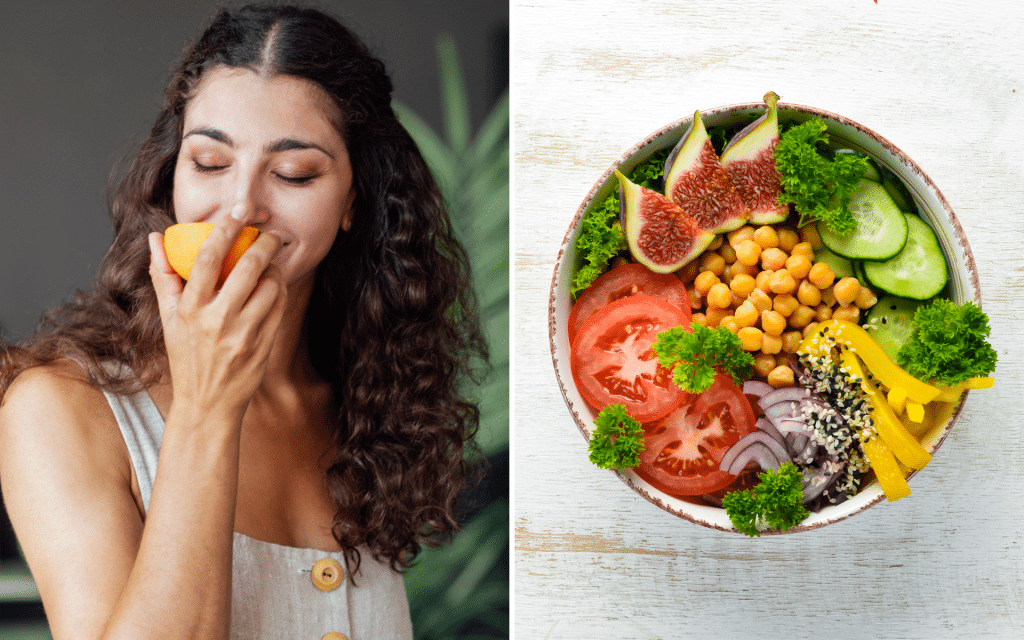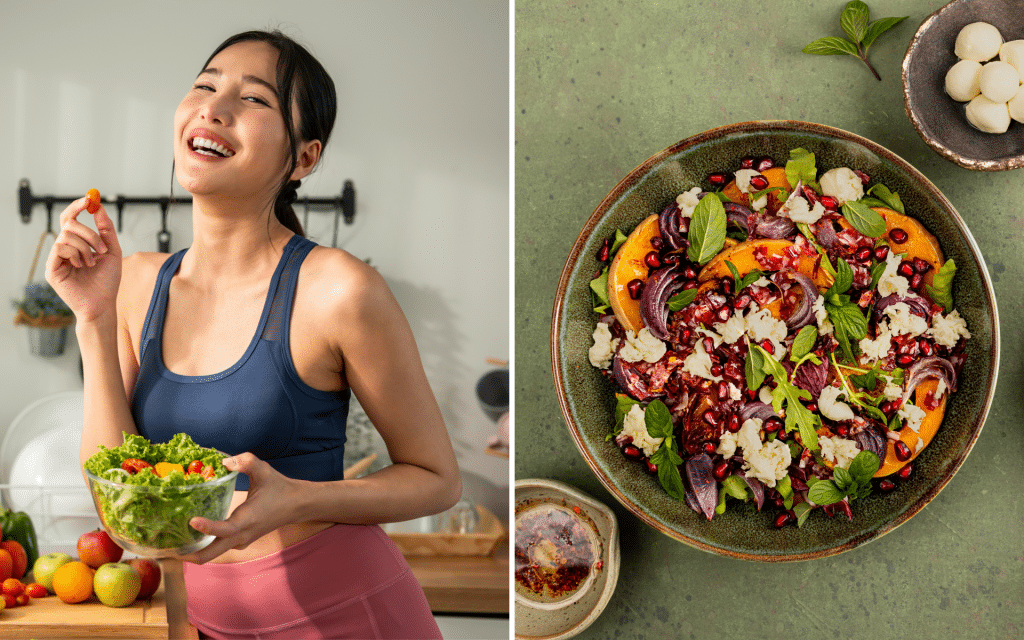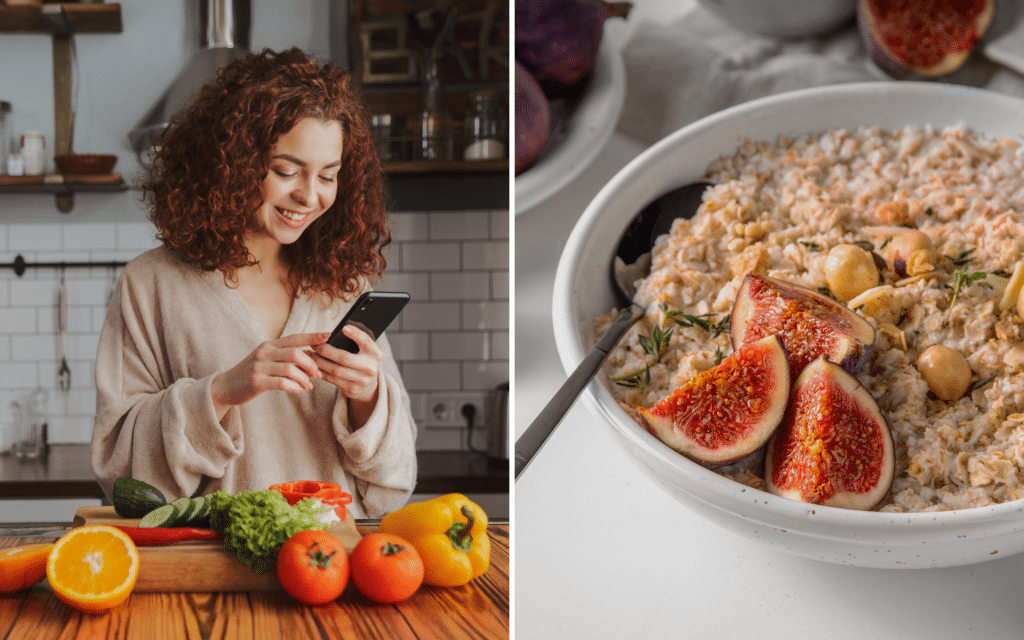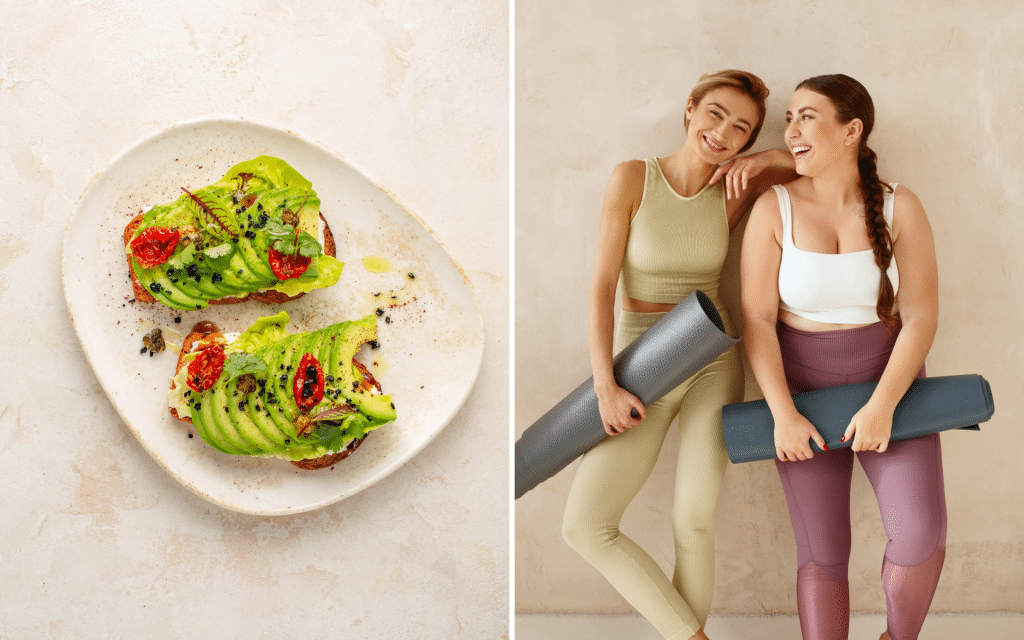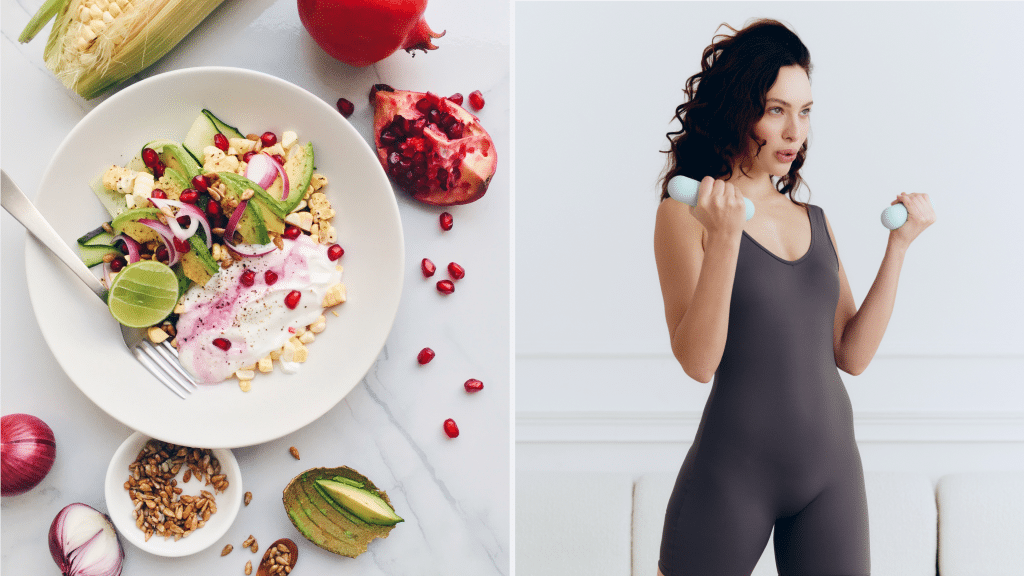Adults are recommended to get at least 0.8 grams of protein per kilogram of body weight per day (1). For example, if you weigh 68 kilograms (about 150 pounds), you need roughly 55 grams of protein daily. Active individuals and those who are aiming to build muscle may require more.
For vegans, meeting these protein needs can be a bit tricky. Many traditional protein sources, such as meat, fish, eggs, and dairy, are off the table. While plant-based foods do provide protein, it’s often in smaller amounts and with varying amino acid profiles. This means that careful planning and variety are the keys to making sure you get all the essential amino acids your body can’t produce on its own.
This guide will walk you through how to create a balanced, high-protein vegan meal plan. You’ll learn about top plant-based protein sources, how to combine foods for complete proteins, and practical tips to meet your needs. With the right knowledge, it’s absolutely possible to thrive on a vegan diet while keeping your protein intake on point.
What Is a Vegan High-Protein Meal Plan?
A vegan high-protein meal plan is a carefully structured eating approach that focuses on meeting protein needs using only plant-based foods. It prioritizes whole grains, legumes, tofu, tempeh, seitan, nuts, seeds, and vegetables that are naturally rich in protein.
The goal of this type of meal plan is to ensure you’re consuming enough protein to support your body’s needs, whether it’s for muscle repair, energy, or overall health. It also emphasizes combining different plant proteins to ensure you get all nine essential amino acids, which are the building blocks of protein that your body cannot make on its own (2).
As plant-based diets often include foods with a lower protein density than animal products, planning is key. A vegan high-protein meal plan helps guide daily choices, making it easier to hit protein goals without sacrificing variety, taste, or nutrition. It’s a way to thrive on a vegan diet while keeping your body strong and nourished.
What Vegan Food Is High-Protein?
Finding high-protein vegan foods can seem daunting at first, but many plant-based options are packed with the protein your body needs. Below, we’ll break it down by food groups to make it easier to understand.
Legumes
Legumes are one of the most protein-rich plant-based food groups. They are also great sources of fiber, iron, and other key nutrients (3). Here are some excellent choices:
- Lentils (18 grams of protein per cooked cup)
- Chickpeas (15 grams of protein per cooked cup)
- Black beans (15 grams of protein per cooked cup)
- Kidney beans (15 grams of protein per cooked cup)
- Peas (8.6 grams of protein per cooked cup)
Grains
While not traditionally thought of as a primary protein source, many grains offer a surprising amount of protein. They’re also versatile and nutrient-rich (4). Consider incorporating these into your meals:
- Quinoa (8 grams of protein per cooked cup)
- Farro (11 grams of protein per cooked cup)
- Bulgur (5.5 grams of protein per cooked cup)
- Oats (6 grams of protein per cooked cup)
- Brown rice (5.5 grams of protein per cooked cup)
Whether you’re a workout beast or just a beginner making your first foray into the world of fitness and dieting – BetterMe has a lot to offer to both newbies and experts! Install the app and experience the versatility first-hand!
Nuts and Seeds
Nuts and seeds are not only high in protein, they’re also rich in healthy fats, vitamins, and minerals (5). Eating them in moderation can provide a nutritional boost to your diet:
- Almonds (6 grams of protein per ounce, about 23 almonds)
- Walnuts (4 grams of protein per ounce)
- Chia seeds (5 grams of protein per 2 tablespoons)
- Flaxseeds (1.3 grams of protein per tablespoon)
- Pumpkin seeds (8 grams of protein per ounce)
Soy Products
Soy foods are some of the richest plant-based protein sources and are incredibly versatile. They often provide complete proteins, which means they contain all the essential amino acids (6). Include the following in your meal plan:
- Tofu (19.88 grams of protein per half-cup)
- Tempeh (15 grams of protein per half-cup)
- Edamame (18.4 grams of protein per cooked cup)
- Soy milk (7 grams of protein per cup)
- Soy-based meat alternatives (varies, but often 15–20 grams per serving)
Vegetables
You may not think of vegetables as a strong source of protein, but some varieties are surprisingly high in it. Adding these to your plate can boost your intake while increasing fiber and nutrients:
- Spinach (5 grams of protein per cooked cup)
- Broccoli (3.7 grams of protein per cooked cup)
- Brussels sprouts (4 grams of protein per cooked cup)
- Kale (3.8 grams of protein per cooked cup)
- Mushrooms (3.4 grams of protein per cooked cup)
Other High-Protein Vegan Foods
There are also some additional plant-based foods that are worth noting. For example:
- Nutritional yeast (8 grams of protein per 2 tablespoons)
- Spirulina (4 grams of protein per tablespoon)
Read more: Vegan Keto Diet: Exploring a Plant-Based Approach to Low-Carb Living
How to Get Enough Protein in a Vegan High-Protein Meal Plan
Meeting protein needs on a vegan diet requires thoughtful and strategic planning. Below are evidence-based strategies to ensure you get enough protein from plant-based sources.
Combine Protein Sources for Complete Amino Acids
Plant proteins are often incomplete, which means they lack one or more essential amino acids that the body cannot produce. By combining foods with different amino acid profiles, you can create complete proteins throughout the day. This method is called “complementary protein pairing” (7).
Examples of complementary pairings include:
- Rice and beans
- Whole-grain bread with peanut butter
- Lentil soup with a side of whole-grain crackers
- Hummus with whole-grain pita
There’s no need to always eat these combinations at the same meal – as long as you include a variety of plant proteins throughout the day, your body will get what it needs.
Include High-Protein Staples in Every Meal
Adding protein-rich foods to each meal and snack helps you stay on track (8). Incorporate diverse sources to keep your meals appealing and well-rounded.
Examples of high-protein foods:
- Legumes (e.g. lentils, chickpeas, black beans)
- Soy products (e.g. tofu, tempeh, edamame)
- Grains such as quinoa, amaranth, and teff
- Nuts and seeds (e.g. almonds, chia seeds, sunflower seeds)
You should aim to have at least one protein-dense ingredient in every meal.
Snack Strategically
Snacking is an excellent opportunity to boost your protein intake between meals (9). Focus on easy-to-prepare, portable options that pack a protein punch.
High-protein snack ideas include:
- Roasted chickpeas or edamame
- A handful of almonds or pumpkin seeds
- A smoothie with protein-packed ingredients (e.g. soy milk, chia seeds, hemp protein powder)
- Whole-grain crackers with hummus
Consider Protein-Enriched Plant-Based Products
Protein-fortified foods can help simplify your meal planning (10), particularly for those on the go or with increased protein needs (e.g. athletes).
Examples include:
- Plant-based protein powders or bars
- High-protein cereals or granola made with nuts and seeds
- Protein-enriched plant milks (e.g. pea protein milk)
When selecting products, prioritize options with minimal added sugar and try not to include too many overly processed items in your diet.
Prioritize Portion Sizes
To optimize your protein intake, pay attention to portion sizes, particularly for less protein-dense foods. For example:
- Having a full cup of cooked lentils instead of a half cup doubles your protein intake.
- Using a generous tablespoon of peanut butter (rather than a smaller amount) adds an extra 4 grams of protein.
Portion management ensures you hit your target intake without drastically altering your diet.
Plan Your Meals in Advance
Meal prepping helps you ensure your protein needs are met, even on busy days (11). Set aside time each week to prepare protein-rich options in advance.
Meal prep tips:
- Cook a big batch of lentils or chickpeas to use in soups, salads, or grain bowls.
- Marinate and bake tofu or tempeh for easy additions to stir-fries or sandwiches.
- Pack small containers of nuts, seeds, or trail mix for on-the-go protein options.
Monitor Your Daily Protein Intake
Track your meals to ensure you’re consuming the recommended protein amount for your body. Tools like apps or meal diaries can help remain consistent. Most adults need to aim for at least 0.8 grams of protein per kilogram of body weight daily (1), although active individuals or those with specific health needs may require more.
How to Balance Macros in a Vegan High-Protein Meal Plan
A balanced diet traditionally consists of carbohydrates, fats, and protein in a ratio that meets the average adult’s energy and bodily needs. A commonly recommended distribution is 45-65% of daily calories from carbohydrates, 20-35% from fats, and 10-35% from protein (12).
On a vegan diet, carbohydrates can come from whole grains, fruits, and vegetables that also contribute fiber and micronutrients. Fats can be sourced from nuts, seeds, avocados, and oils such as olive or flaxseed oil.
To meet the protein requirements that are highlighted in this meal plan, focusing on complete sources such as soy products and a variety of plant proteins will ensure adequate amino acid intake.
Adjusting Ratios for Specific Goals
While the general ratios work for most people, some goals or lifestyles may require adjusting the balance.
For Gaining Muscle
A high-protein vegetarian diet plan for muscle gain may have you increasing protein intake to the higher end of the recommended range, potentially adjusting to 25-30% of calories from protein (13)
This supports recovery and growth, particularly for those who are engaging in strength training. Carbohydrates remain important to fuel workouts, typically around 50-55% (14), while fats fill the remaining 20-25% (12).
For Weight Loss or Fat Reduction
A vegan high-protein meal plan for weight loss may have slightly higher protein levels to promote satiety and preserve muscle mass while reducing calories overall (15).
Lowering carbohydrates, often to around 40-50%, can help reduce caloric density, focusing on whole, minimally processed plant foods. Healthy fats maintain metabolic function and hormonal health, generally staying around 25-30% (16).
For High Activity Levels
Active individuals or athletes often require slight increases in both protein and carbohydrates to meet energy and recovery needs.
For endurance-based activities, carbohydrates may rise to 60-65% of total calories as the primary energy source, with protein and fats strategically balanced to avoid fatiguing deficiencies (17).
How to Create a Vegan High-Protein Meal Plan
Planning your meals thoughtfully is essential to ensuring you meet your protein needs without compromising on taste, nutrition, or convenience. Below, we walk through a step-by-step process to help you create a vegan high-protein meal plan that is both nourishing and practical.
Step 1: Determine Your Macros
Start by calculating your macronutrient requirements. Protein needs vary based on factors such as age, body weight, activity level, and goals.
Generally, aim for 0.8-1.2 grams of protein per kilogram of body weight for the average adult (1) and up to 1.6-2.0 grams per kilogram for those involved in strength training or intense physical activity (13).
Once your protein target is established, divide the remaining calories between carbohydrates (45-65% of total) and fats (20-35% of total) for a balanced nutrient profile. Use online calculators or apps to fine-tune these numbers based on your energy needs.
Evidence suggests that spreading protein intake evenly throughout the day may enhance muscle synthesis (18), so aim to include a good dose of protein in each meal and snack.
Step 2: Plan Balanced Vegan Meals
When planning meals, focus on incorporating high-protein plant-based foods alongside nutrient-dense whole grains, vegetables, and healthy fats. Choose diverse sources to ensure you get all the essential amino acids. For each meal:
- Include a primary protein source such as tofu, tempeh, lentils, or edamame.
- Pair with complementary foods such as whole grains and/or nuts to enhance protein quality.
- Add plenty of vegetables and whole grains to supply fiber and additional nutrients.
A practical tip when choosing foods is to consider their versatility. For example, tofu can be quickly stir-fried, crumbled for scrambles, or blended into sauces. Similarly, lentils can form the base of soups, burgers, or salads, reducing monotony. Our previous post goes into great detail about the vegan weight loss meal plan.
Step 3: Prep for Success
Meal prep is essential for maintaining a high-protein vegan diet (11), particularly on busy days. Start by identifying foods that can be prepped in advance:
- Cook large batches of grains such as quinoa or brown rice, as they store well in the refrigerator for 4-5 days.
- Roast or steam hearty vegetables (e.g. sweet potatoes, Brussels sprouts) for easy sides.
- Prepare lentils, chickpeas, or black beans in bulk and store them for use in salads, wraps, or stir-fries.
Avoid freezing delicate vegetables such as zucchini or cucumbers, as they can become mushy. Also, certain sauces made with tofu (e.g. silken tofu-based dressings) lose their texture upon freezing. Prioritize prepping items that maintain flavor and texture, such as baked tempeh strips or granola made of oats and nuts for snacks.
Step 4: Assemble a 3-Day Sample Meal Plan
To put the plan into action, use the framework outlined above. Here’s a 3-day sample high-protein vegan meal plan to get you started:
Day 1
- Breakfast: Tofu scramble with spinach, tomatoes, and nutritional yeast; 1 slice whole-grain toast with almond butter.
- Lunch: Lentil and quinoa salad with chopped vegetables, tahini dressing, and pumpkin seeds.
- Snack: Roasted edamame and an apple.
- Dinner: Tempeh stir-fry with broccoli, carrots, soy sauce, and jasmine rice.
Day 2
- Breakfast: Smoothie with soy milk, frozen berries, a tablespoon of chia seeds, and a scoop of vegan protein powder.
- Lunch: Chickpea and spinach curry served with brown rice.
- Snack: Celery sticks with hummus and a handful of walnuts.
- Dinner: Grilled marinated tofu served with roasted Brussels sprouts and mashed sweet potatoes.
Day 3
- Breakfast: Overnight oats made with oat milk, almond butter, chia seeds, and a handful of hemp hearts.
- Lunch: Black bean burrito bowl with corn, tomatoes, avocado, and salsa over quinoa.
- Snack: A handful of almonds and a sesame-seed protein bar.
- Dinner: Vegan chili made with kidney beans, lentils, and vegetables; served with a slice of whole-grain bread.
Step 5: Evaluate and Adjust
Consistency is key, but flexibility is also important. After a week or two, review your plan to see how well it aligns with your goals and how your body feels. If you’re struggling to hit your protein targets, consider increasing your portion sizes or adding a high-protein snack.
Conversely, if you’re feeling overly full or sluggish, reduce your portions or reallocate macronutrients.
What Are Some Easy Vegan High-Protein Meal Plan Recipes?
Now that you have a better understanding of how to create a vegan high-protein meal plan, here are some easy recipes to get you started:
- Smashed Edamame Toast: A quick and versatile recipe that combines edamame, tahini, and avocado for a protein-packed spread. Perfect for breakfast or as a topping for salads and grain bowls. Check out the recipe here.
- Tofu Noodle Bowl with Almond Butter Sauce: This dish features five-spice tofu, whole wheat noodles, and a creamy almond butter sauce, delivering over 30 grams of protein per serving. Find the recipe here.
- Garlicky Quinoa and Lentils with Tofu Ricotta: A hearty bowl with quinoa, lentils, and a creamy tofu-based ricotta, topped with garlicky pepitas for crunch. Explore the recipe here.
- Vegan Tahini Tofu and Pasta: A simple yet flavorful dish combining tahini and tofu for a creamy, protein-rich pasta meal. Get the recipe here.
- Vegan Sheet Pan “Beef” and Broccoli: A one-pan meal featuring tofu and broccoli, seasoned to perfection for a high-protein, easy dinner. View the recipe here.
These recipes are straightforward, delicious, and perfect for anyone looking to boost their protein intake on a vegan diet.
What Are the Benefits of a Vegan High-Protein Meal Plan?
A vegan high-protein meal plan combines the advantages of plant-based eating with the specific benefits of consuming an adequate amount of protein. It has several potential benefits:
- Improved Heart Health
A well-planned vegan diet is rich in fiber, low in saturated fat, and free of cholesterol. These factors are linked to better heart health.
Foods such as legumes, whole grains, and nuts can reduce LDL cholesterol and lower blood pressure. Adding plant-based protein ensures heart health is supported while meeting the body’s repair and maintenance needs (19).
- Enhanced Muscle Health and Recovery
Protein is essential for building and repairing tissues. Including high-protein plant foods such as tofu, lentils, and quinoa can support muscle synthesis (13).
This is particularly helpful for active individuals and those who are recovering from injuries. A vegan diet that is rich in amino acids from various plant sources ensures the body receives what it needs for recovery (20).
- Better Digestive Function
Vegan diets are naturally high in fiber. Fiber supports healthy digestion by improving gut motility and feeding beneficial gut bacteria (21).
When high-protein options such as beans and seeds are included, you combine digestive benefits with protein intake, making meals more filling and nutrient-dense.
- Weight Management Support
Plant-based protein sources tend to be lower in calories and higher in fiber compared to animal products.
Fiber promotes satiety, which helps you feel full for longer. This can assist with managing calorie intake (22). Combining this with adequate protein can preserve lean muscle mass during weight loss.
- Reduced Risk of Chronic Diseases
Plant-based diets are associated with a lower risk of conditions such as type 2 diabetes and certain cancers. Whole plant foods are rich in antioxidants and phytochemicals, which may protect the body from oxidative stress (23).
High-protein options like tempeh and almonds come with vitamins and minerals that add further health benefits.
Reasons why BetterMe is a safe bet: a wide range of calorie-blasting workouts, finger-licking recipes, 24/7 support, challenges that’ll keep you on your best game, and that just scratches the surface! Start using our app and watch the magic happen.
- Blood Sugar Regulation
Proteins help stabilize blood sugar levels by slowing digestion. When paired with fiber from plant-based sources, blood sugar spikes are minimized. This can benefit individuals with insulin sensitivity or diabetes (24). Protein-rich legumes, nuts, and seeds all contribute to this stabilization.
- Eco-Friendly Nutritional Choices
A vegan high-protein meal plan aligns closely with environmental sustainability. Plant-based foods require fewer natural resources and produce fewer greenhouse gas emissions than animal-based options. This plan balances personal health with planetary health (25).
- Vital Nutrient Intake
Plant protein sources are often loaded with additional nutrients. For example, chickpeas supply iron, calcium, and magnesium. Nuts and seeds deliver vitamin E and healthy fats. Choosing a variety of these foods ensures a broader spectrum of nourishment.
Read more: Veggie Snacks to Conquer Cravings
Mistakes to Avoid in a Vegan High-Protein Meal Plan
When creating a vegan high-protein meal plan, there are several common pitfalls that can affect your health or the effectiveness of your diet. Here’s how to sidestep these issues:
- Relying Too Heavily on Ultra-Processed Foods
Plant-based protein alternatives, such as vegan sausages or protein bars, can be convenient.
However, these foods are often heavily processed and may contain high levels of sodium, added sugars, or unhealthy fats. An over-reliance on these products could lead to inadequate nutrient intake or potential health risks over time (26).
Instead, focus on whole food sources such as lentils, quinoa, tofu, and tempeh for a more balanced and nutrient-rich approach.
- Skipping Complementary Proteins
Most plant proteins are incomplete, which means they don’t contain all the essential amino acids your body needs (26). While soy is an exception, other plant-based proteins require pairing with complementary foods to form complete proteins.
For example, pair beans with rice or whole-grain bread with nut butter. Skipping these combinations on a regular basis can result in suboptimal protein utilization by the body. You don’t always need to eat the complementary proteins at the same time, but make sure to include a variety of different protein sources in your diet to hit all your bases overall.
- Underestimating Macronutrient Balance
Focusing only on protein while neglecting carbohydrates and fats can lead to a poorly balanced diet. Carbohydrates are essential for energy, while healthy fats support brain function and hormone production (14, 16).
Ensure your meal plan maintains a reasonable balance, with approximately 10-35% of calories from protein, 20-35% from fat, and 45-65% from carbohydrates (12).
- Not Meeting Micronutrient Needs
Certain key nutrients, such as vitamin B12, iron, zinc, calcium, and omega-3 fatty acids, are less abundant or bioavailable in plant-based foods (26). Neglecting these can cause deficiencies over time.
To avoid this, include fortified foods (e.g. fortified plant milks, nutritional yeast) or consider taking supplements, particularly for B12 and omega-3. Focus on high-iron foods such as lentils and pumpkin seeds, paired with vitamin C-rich sources for improved absorption.
- Skipping Adequate Meal Planning
A lack of preparation can result in inadequate protein intake or reliance on unhealthy choices. Without proper meal prep, it’s easy to skip meals or grab low-nutrient snacks.
Dedicate time to planning and prepping protein-rich options such as cooked quinoa, roasted chickpeas, or marinated tofu. This ensures you have healthy, high-protein meals ready even on busy days (11)
- Overlooking Portion Sizes
Consuming insufficient portions of protein-rich foods is a common issue, particularly with less protein-dense options such as grains or vegetables.
Pay attention to portion sizes and adjust according to your protein requirements. For example, increase your usual serving of quinoa or chickpeas in dishes to meet your daily goals.
- Failing to Hydrate Adequately
High-protein diets can increase your body’s requirement for water, as protein metabolism produces waste like urea (27).
Insufficient hydration can lead to discomfort or reduced kidney efficiency (28). Stay hydrated by drinking plenty of water and including hydrating foods such as fruits and vegetables in your diet.
- Overcomplicating Your Diet
Some people make vegan high-protein meal plans overly complex, leading to frustration or diet fatigue. This could involve tracking every gram of protein or creating elaborate meals every day. Instead, start simple. Choose one main high-protein food for each meal and pair it with nutrient-dense sides.
Yes, you can get enough protein on a vegan diet with proper planning. Consuming a variety of protein-rich plant foods, such as legumes, tofu, tempeh, seitan, nuts, seeds, and whole grains, will ensure you meet your protein needs. Combining different plant proteins throughout the day provides all essential amino acids. Some of the best vegan protein sources include lentils, chickpeas, black beans, edamame, tofu, tempeh, seitan, quinoa, chia seeds, hemp seeds, almonds, and nutritional yeast. These foods are high in protein and rich in vitamins, minerals, and fiber. Yes, plant-based proteins can support muscle growth when you consume enough protein overall and include a range of sources to ensure you get all essential amino acids. Soy-based foods such as tofu and tempeh are particularly effective as they contain complete proteins. Adequate resistance training combined with a high-protein vegan diet is key. Protein shakes aren’t necessary for most vegans if they’re meeting their protein needs through whole foods. However, they can be a convenient option for those with higher protein requirements, such as athletes, or during busy times when preparing meals is challenging. Choose plant-based protein powders that are low in added sugars when needed.Frequently Asked Questions
Can you get enough protein on a vegan diet?
What are the best vegan protein sources?
Do plant-based proteins help with muscle growth?
Are protein shakes necessary for vegans?
The Bottom Line
Vegan high-protein diets are a viable option for those who are looking to balance nutrition with plant-based eating. They offer numerous potential benefits, including improved heart health, muscle recovery, better digestion, and environmental sustainability.
However, success with this dietary approach hinges on thoughtful planning. Ensuring variety, meeting nutrient needs such as vitamin B12 and iron, and balancing macronutrients are crucial to avoid potential pitfalls.
DISCLAIMER:
This article is intended for general informational purposes only and does not serve to address individual circumstances. It is not a substitute for professional advice or help and should not be relied on for making any kind of decision-making. Any action taken as a direct or indirect result of the information in this article is entirely at your own risk and is your sole responsibility.
BetterMe, its content staff, and its medical advisors accept no responsibility for inaccuracies, errors, misstatements, inconsistencies, or omissions and specifically disclaim any liability, loss or risk, personal, professional or otherwise, which may be incurred as a consequence, directly or indirectly, of the use and/or application of any content.
You should always seek the advice of your physician or other qualified health provider with any questions you may have regarding a medical condition or your specific situation. Never disregard professional medical advice or delay seeking it because of BetterMe content. If you suspect or think you may have a medical emergency, call your doctor.
SOURCES:
- Protein for Life: Review of Optimal Protein Intake, Sustainable Dietary Sources and the Effect on Appetite in Ageing Adults (2018, mdpi.com)
- Biochemistry, Essential Amino Acids (2024, ncbi.nlm.nih.gov)
- Legumes: Health Benefits and Culinary Approaches to Increase Intake (2015, diabetesjournals.org)
- Grains – a major source of sustainable protein for health (2022, pmc.ncbi.nlm.nih.gov)
- Composition of Nuts and Their Potential Health Benefits—An Overview (2022, mdpi.com)
- The health effects of soy: A reference guide for health professionals (2022, frontiersin.org)
- High-protein snacks to build muscle and keep hunger at bay (2024, health.harvard.edu)
- Combining Plant Proteins to Achieve Amino Acid Profiles Adapted to Various Nutritional Objectives—An Exploratory Analysis Using Linear Programming (2022, frontiersin.org)
- What Is a Snack, Why Do We Snack, and How Can We Choose Better Snacks? A Review of the Definitions of Snacking, Motivations to Snack, Contributions to Dietary Intake, and Recommendations for Improvement (2016, sciencedirect.com)
- Food Fortification: The Advantages, Disadvantages and Lessons from Sight and Life Programs (2021, mdpi.com)
- Meal planning is associated with food variety, diet quality and body weight status in a large sample of French adults (2017, ijbnpa.biomedcentral.com)
- Dietary reference intakes tables: Reference values for macronutrients (2023, canada.ca)
- Higher compared with lower dietary protein during an energy deficit combined with intense exercise promotes greater lean mass gain and fat mass loss: a randomized trial (2016, sciencedirect.com)
- High-Quality Carbohydrates and Physical Performance (2018, journals.lww.com)
- Protein intake is more stable than carbohydrate or fat intake across various US demographic groups and international populations (2020, sciencedirect.com)
- Editorial: The role of dietary fatty acids in metabolic health (2023, frontiersin.org)
- Nutrition and the Athlete: Fueling Your Sport (n.d., digitalcommons.unl.edu)
- Dietary Protein Distribution Positively Influences 24-h Muscle Protein Synthesis in Healthy Adults (2014, pmc.ncbi.nlm.nih.gov)
- The Effect of a Vegan Diet on the Cardiovascular System (2023, mdpi.com)
- Dietary Protein and Amino Acids in Vegetarian Diets—A Review (2019, mdpi.com)
- Gut microbiome signatures of vegan, vegetarian and omnivore diets and associated health outcomes across 21,561 individuals (2025, nature.com)
- Unravelling the Effects of Soluble Dietary Fibre Supplementation on Energy Intake and Perceived Satiety in Healthy Adults: Evidence from Systematic Review and Meta-Analysis of Randomised-Controlled Trials (2019, mdpi.com)
- Vegan diet: nutritional components, implementation, and effects on adults’ health (2023, frontiersin.org)
- A plant-based diet for the prevention and treatment of type 2 diabetes (2017, pmc.ncbi.nlm.nih.gov)
- Plant-Based Dietary Patterns for Human and Planetary Health (2022, mdpi.com)
- The Impact of a Vegan Diet on Many Aspects of Health: The Overlooked Side of Veganism (2023, pmc.ncbi.nlm.nih.gov)
- Controversies Surrounding High-Protein Diet Intake: Satiating Effect and Kidney and Bone Health (2015, pmc.ncbi.nlm.nih.gov)
- Adult Dehydration (2025, ncbi.nlm.nih.gov)
